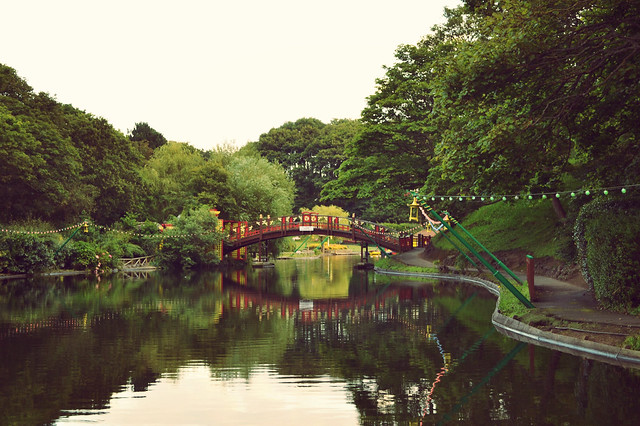Peasholm Park, in Scarborough, North Yorkshire, is notable for its Orient-inspired design features – the island pagoda, Chinese statues and suspended lanterns, just to name a few examples.
Above: Peasholm Lake and bridge (Copyright: Stories From Scarborough)
This picturesque park was designed in the early 1900s by Borough Engineer Harry W. Smith – creator of many of the seaside town’s landmarks (Floral Hall, the South Bay Pool and Northstead Manor Gardens for example), Peasholm Park was built on land that was formerly part of the Northstead Estate. More specifically, development focused on an area then called Tucker’s Field, transforming a muddy expanse into landscaped gardens.
Above: An early image of the new park, before the building of the pagoda (source)
Decades earlier, during the late 1800s, Victorian Britain had developed an obsession for art and architecture from across the world, and many designers eagerly appropriated styles imported from China, Japan and other locations from across Asia. Indeed, Scarborough’s aquarium was inspired by Hindu temples, and the Turkish Baths, would eventually become an Indian Village attraction in the early 1900s. Seaside towns sought to emulate far away places in the attractions they offered to visitors, although often perpetuated crude and inaccurate stereotypes in the process.
Above: Peasholm Park (source)
Even further back, Chinese pottery was much coveted by traders and consumers in the 1700s, so much so that English potters began to imitate their styles (Thomas Minton is typically credited with pioneering this approach). In order to sell this so-called Willow Pattern, Minton and his contemporaries imbued their designs with an exotic story – typically involving a wealthy mandarin and his daughter’s illicit love affair.
Above: Some of Peasholm’s subtle features (Copyright: Stories From Scarborough)
Ironically enough, such stories were the inventions of enterprising English businessmen, such as Minton, and were not directly derived from authentic Chinese tales per se. Cultural and historical traditions were re-imagined for British consumers.
Above: Peasholm Park re-imagines the fictional landscape in which Minton’s story took place (source)
Harry W. Smith was inspired by the Willow Pattern story, and, reputedly also by the beauty of Japanese gardens and architecture. He sought to represent these various diverse threads of inspiration within the park, which opened on June 19th, 1912, following purchase of the land by the Scarborough Corporation during the preceding year.
Above: In 1927 the Naval Warfare display was launched at the park (source)
Smith wanted to create authentic-looking gardens, and therefore sought assistance from local alderman Colonel J.R. Twentyman – a Chinese connoisseur of sorts and recent purchaser of Kirby Misperton Hall (later Flamingoland).
Twentyman had hired Chinese and Italian workers to construct gardens and structures inspired by their respective countries within the grounds of his sprawling new home. He also commissioned statues and ornaments, a selection of which were purchased for Peasholm in 1931, and can still be seen today within the park.
The crowning jewel in Peasholm’s crown, however, was the impressive pagoda, which was designed by architect George W. Alderson and built in 1929. Illuminated at night, perched at the height of a cascading waterfall, this imitation of a structure found in both China and Japan, obviously does not perform the same function or meaning in a North Yorkshire seaside town, but nonetheless became a well loved landmark for visitors. Sadly, in recent decades it has suffered attacks of vandalism, although has recently been restored anew.
Above: The magical illuminations and the pagoda (source)
Peasholm Park offers a glimpse into perceptions of Chinese (and Japanese) culture and design by Edwardian Britons. Whilst the park is worlds away from the lands it seeks to emulate, it nonetheless creates a striking visual experience for visitors.
Do you know anything more about Peasholm’s heritage? Or about the park in general? Please comment below or visit the Facebook Page for pictures, memories and more.
Sources
This article by Dav White
Brief history of Kirby Misperton Hall (with reference to Colonel Twentyman)
More about the Willow Pattern here
Materials held at the Scarborough Room at Scarborough Library








Pingback: The North Bay Miniature Railway | Stories From Scarborough
Pingback: The Grand Opening of Peasholm Park | Stories From Scarborough
Pingback: The Story of the South Bay Pool | Stories From Scarborough
What wonderful pictures. They bring back tremendous memories for me.
I always used to love going to see the naval warfare, the airplanes being launched along a wire from by the road.
The real highlight of Peasholm Park was the bandstand. I spent a lot of my childhood watching brass bands play there, desperately wishing I could have a go.
When I was in my 20’s, that wish was finally granted, as a band I played in in Shildon, County Durham, was invited to play in it on Sunday afternoon. The excitement of being taken to the bandstand in a rowing boat was tremendous, and playing there was as good as I had always imagined. I didn’t want to leave!
What a lovely memory Paul! Thanks for sharing it. As a former brass bander myself, I often longed to play there, but sadly never got the chance to.
Thanks again,
Sarah (Stories From Scarborough)
Pingback: Scarborough’s Glorious Gardens: Part I | Stories From Scarborough